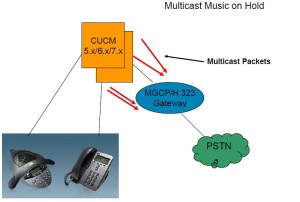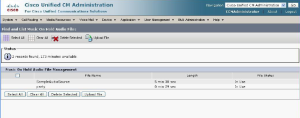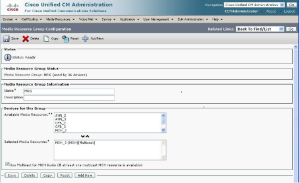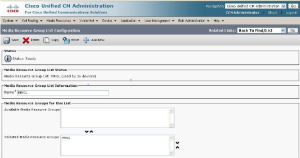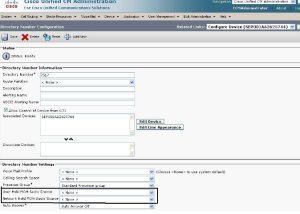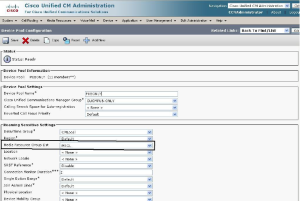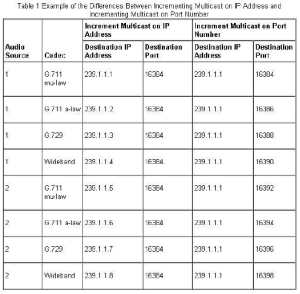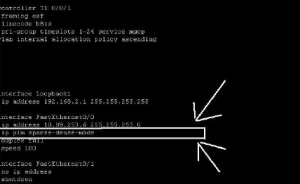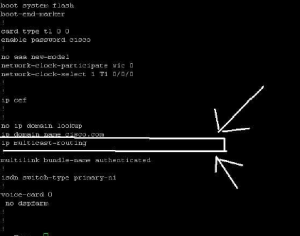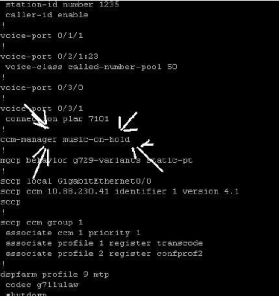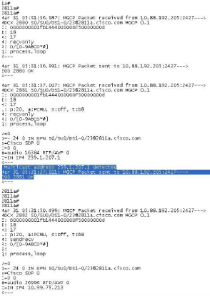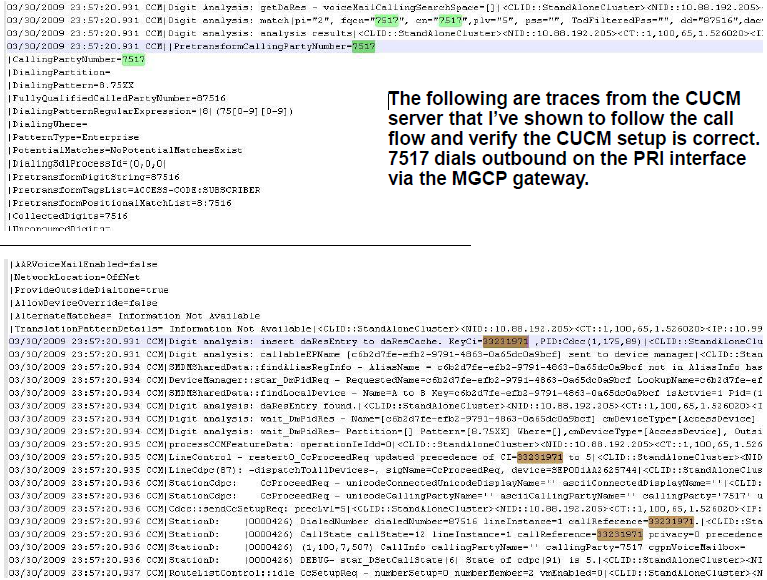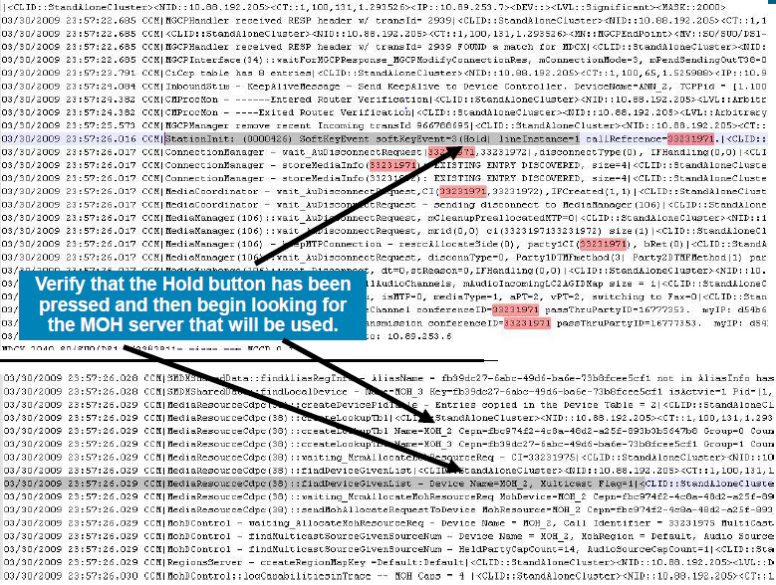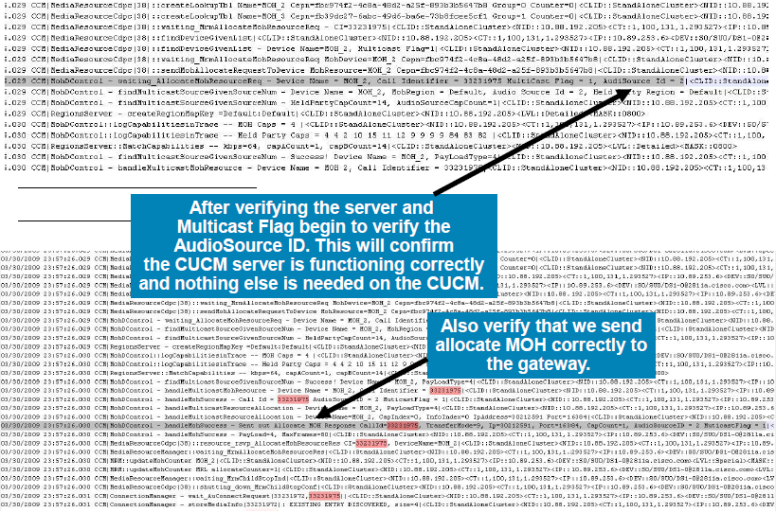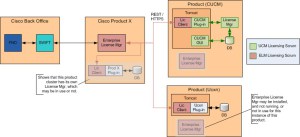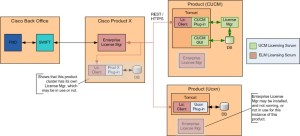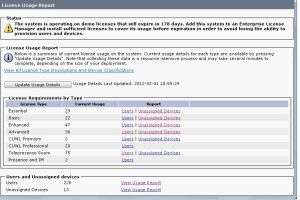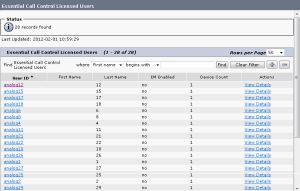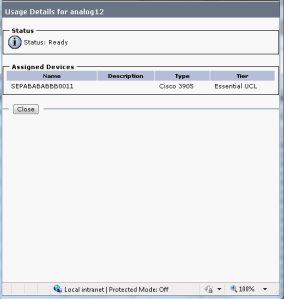Introduction: Mandatory VMware Products and Services
Note: This page only covers VMware product/version/feature support.
-
- It does not cover compute/network/storage hardware support policy for UC virtualization.
- It does not cover application co-residency support policy for UC virtualizatoin.
- See other links at http://www.cisco.com/go/uc-virtualized for these details.
VMware vSphere ESXi is mandatory for UC virtualization and UC on UCS.
-
- UC is only supported on UCS servers with VMware vSphere ESXi.
- See rest of this page for other details on VMware product, version and feature support.
- Nonvirtualized, physical, or bare-metal installations are not supported for UC on UCS.
VMware vCenter is:
-
- Mandatory for all Specs-based deployments
- Optional for Tested Reference Configuration deployments.
For UC on UCS, VMware vSphere ESXi and vCenter may be purchased from Cisco or customer provided. For specs-based with HP/IBM, all VMware software must be customer-provided. SeeBefore You Buy or Deploy – Considerations for Design and Procurement for information on VMware purchase options.
Compatibility of UC apps/versions with VMware vSphere ESXi versions varies by UC app and is outlined later in this document. See the following links for details on “legacy” virtualization support (i.e. 7.x of UC apps with VMware vSphere on limited 3rd-party servers):
-
Note: in all cases, the customer is required to have a valid service contract (either with Cisco or with VMware, depending on what/how purchased) to be supported. See Services and Support Contracts for VMware are Required for how to ensure this is done for different Editions of Vmware vSphere ESXi.
Supported Virtualization Hypervisor Vendors
At this time, the only vendor supported for UC is VMware.
Other vendors/products – such as Microsoft Hyper-V, Citrix Xen, Red Hat KVM – are not supported for Cisco UC virtualization.
Supported VMware Products
VMware vSphere ESXi is required for Cisco UC virtualization.
- ESX and ESXi are architecture options for VMware vSphere (click here for a comparison). UC only supports ESXi. Recall that vSphere 3.x and 4.x offered both options, but 5.0+ only offers ESXi.
- VMware vSphere ESX, regardless of version, is not supported for UC. This is due to technical reasons and VMware’s direction to transition from ESX to ESXi. Note a VMware ESX cluster can contain VMware ESXi servers running Cisco Unified Communications.
- No other VMware server virtualization products are supported.
Supported Versions of VMware vSphere ESXi
The minimum version for VMware vSphere ESXi is 4.0. But note a higher minimum version may be required depending on what UC apps/versions you run (see tables below) and what hardware you select.
- Note that use of VMware vSphere ESXi 4.1 requires disabling the “LRO” setting as described here.
- Versions of VMware vSphere ESXi prior to 4.0 are not supported due to technical reasons.
- Each UC app/version will specify the required compatible Major Releases and Minor Releases of VMware vSphere ESXi (e.g. 4.0 or 4.1) in the tables below.
- Unlisted Major/Minor versions are not supported.
- Unless otherwise indicated, the base Major/Minor version shown is the minimum required.
- Some UC apps will also require a minimum Maintenance Release and will indicate if this is the case. Otherwise UC does not specify or recommend patches, updates or Maintenance Releases (e.g. 4.0 U1) for a required Major/Minor Release of vSphere ESXi. Follow recommendations of the server vendor and VMware for what you should use. Unless otherwise indicated by a UC app, UC supports all VMware vSphere ESXi patches, updates and Maintenance Releases for a supported Major/Minor Release at time of VMware launch as long as the server vendor supports them.
VMware vSphere ESXi Version Support for Call Processing and System Management Applications
| Application |
VMware vSphere ESXi 4.0 |
VMware vSphere ESXi 4.1
Cisco UC Virt. Foundation 4.1* |
VMware vSphere ESXi 5.0
Cisco UC Virt. Foundation 5.0* |
VMware vSphere ESXi 5.1
Cisco UC Virt. Foundation 5.1* |
| Unified Communications Manager (Unified CM) |
8.0(2+), 8.5(x), 8.6(x), 9.0(1), 9.1(x) |
8.0(2+), 8.5(x), 8.6(x), 9.0(1), 9.1(x) |
8.0(2+), 8.5(x), 8.6(x), 9.0(1), 9.1(x) |
8.0(2+), 8.5(x), 8.6(x), 9.0(1), 9.1(x) |
| Cisco Paging Server for Unified CM |
8.3+ |
8.3+ |
8.3+ |
Not supported |
| Unified CM IM & Presence Service |
Not supported |
9.0(x), 9.1(x) |
9.0(x), 9.1(x) |
9.0(x), 9.1(x) |
| Cisco Business Edition 6000 |
Click here for details |
| Cisco Emergency Responder (CER) |
8.5(x), 8.6(x), 8.7(x), 9.0(x) |
8.5(x), 8.6(x), 8.7(x), 9.0(x) |
8.5(x), 8.6(x), 8.7(x), 9.0(x) |
8.7(x), 9.0(x) |
| Session Manager Edition (SME) |
8.5(x), 8.6(x), 9.0(x), 9.1(x) |
8.5(x), 8.6(x), 9.0(x), 9.1(x) |
8.5(x), 8.6(x), 9.0(x), 9.1(x) |
8.5(x), 8.6(x), 9.0(x), 9.1(x) |
| Unified Attendant Consoles |
8.0(3+), 8.5(x) |
8.6(x) |
8.6(x) |
8.6(x) |
| Cisco Intercompany Media Engine (CIME) |
Not supported |
8.6(2+), 9.0(x) |
8.6(2+), 9.0(x) |
8.6(2+), 9.0(x) |
Cisco UC Management Suite
- (Cisco UPM, UOM, USM, USSM)
Cisco Prime UC Management Suite
- (Prime UPM, Prime UOM, Prime USM)
|
8.0 and later |
8.0 and later |
8.6 and later |
UPM: 8.6 and later
UOM/USM/USSM:Not supported |
| Prime Collaboration Manager |
Not supported |
Not supported |
1.2 and later |
Not supported |
Prime Collaboration Provisioning (PCP)
Prime Collaboration Assurance (PCA) |
9.x |
9.x |
9.x |
9.x |
- For applications that are allowed “on-box” with Cisco Business Edition 6000, this also includes version compatibility with Cisco UC Virtualization Hypervisor which is only supported for use with Cisco Business Edition 6000.
VMware vSphere ESXi Version Support for Messaging and Presence Applications
| Application |
VMware vSphere ESXi 4.0 |
VMware vSphere ESXi 4.1
Cisco UC Virtualization Foundation 4.1* |
VMware vSphere ESXi 5.0
Cisco UC Virtualization Foundation 5.0* |
VMware vSphere ESXi 5.1
Cisco UC Virtualization Foundation 5.1* |
| Cisco Unity Connection |
8.0(2)+, 8.5(x), 8.6(x), 9.0(x), 9.1(x) |
8.0(2)+, 8.5(x), 8.6(x), 9.0(x), 9.1(x) |
8.0(2)+, 8.5(x), 8.6(x), 9.0(x), 9.1(x) |
8.0(2)+, 8.5(x), 8.6(x), 9.0(x), 9.1(x) |
| Cisco Unity |
7.x and later |
7.x and later |
7.x and later |
7.x and later |
| Cisco Unified Presence |
8.0(2)+ |
8.0(2)+ |
8.6(1)+ |
8.6(4)+ |
- For applications that are allowed “on-box” with Cisco Business Edition 6000, this also includes version compatibility with Cisco UC Virtualization Hypervisor which is only supported for use with Cisco Business Edition 6000.
VMware vSphere ESXi Version Support for Contact Center Applications
 |
Note: |
For Virtual Machines that need more than 4 vCPUs, the VMware vSphere ESXi 4.1 Enterprise Plus licensing is required (8 way virtual SMP capability and applicable to ESXi 4.x only). The VMware vSphere 4.1 Enterprise Plus license can be procured from the Cisco build-to-order or directly from the VMware (see VMware Purchasing section above.) |
Notation Convention. The 8.0(1+) means 8.0(x) (x=1 and later 2,3,etc.) The 8.0(x) SU1+ means 8.0(x) and thereafter SU such as SU1, SU2, SU3, etc. in the 8.0(x). The 8.0(1)+ means 8.0(1) and thereafter releases like 8.0(1), 8.0(2) or 8.5(1), etc. The 8.x means any releases in that train: 8.0, 8.1, etc. The same is for other major releases (9, 10, etc.) using the + or x convention.
| Application |
VMware vSphere ESXi 4.0 and 4.0 Updates |
VMware vSphere ESXi 4.1 and 4.1 Updates |
VMware vSphere ESXi 5.0 and 5.0 Updates |
VMware vSphere ESXi 5.1 and 5.1 Updates |
| Unified Contact Center Express / IP IVR |
8.0(2+), 8.5(1+), 9.x |
8.0(2) SU2+, 8.5(1+), 9.x |
8.0(2) SU4+, 8.5(1) SU2+, 9.x |
8.5(1)SU4+, 9.0(2)+ |
Cisco Unified Work Force Optimization (WFO),
Quality Management (QM),
and Work Force Management (WFM) |
8.5(1) |
8.5(2+), 9.x |
8.5(2+), 9.x |
Not supported |
| Unified Contact Center Enterprise |
ESXi 4.0 Update 1 (minimum required). See below |
See below |
See below |
Not supported |
– Router, Logger, Rogger, Agent PG, MR PG,
VRU PG, Administration and Data Server (AW, AW-CONFIG, AW-HDS, AW-HDS-DDS, HDS-DDS), Administration Client,
Outbound Option with SIP Dialer, Support Tools (not supported in 8.5x and later) |
8.0(2+), 8.5(1+) |
8.0(2+), 8.5(1+) |
8.5(1+), 9.x |
Not supported |
| Cisco Packaged Contact Center Enterprise |
Not supported |
Not supported |
9.x |
Not supported |
| Cisco Unified Intelligence Center |
8.0(3), 8.0(4) |
8.5(2), 8.5(3), 8.5(4) |
8.5(4+), 9.x |
Not supported |
| Unified Contact Center Management Portal |
8.0(2+), 8.5(1+) |
8.0(2+), 8.5(1+) |
8.5(1+), 9.x |
Not supported |
| Unified Customer Voice Portal (all components) |
8.0(1+) or 8.5(1+) |
8.0(1+) or 8.5(1+) |
8.5(1+), 9.x |
Not supported |
| Cisco MediaSense |
8.5(1) |
8.5(2+) |
8.5(4+), 9.x |
Not supported |
| Cisco SocialMiner |
8.5(1+) |
8.5(1+) |
8.5(3+), 9.x |
Not supported |
| Unified Email Interaction Manager and Web Interaction Manager |
4.3(2+) |
4.3(2+), 4.4(1+) |
4.4(1+), 9.x |
Not supported |
| Cisco Finesse |
Not supported |
8.5(3+) |
8.5(3+), 9.x |
Not supported |
VMware vSphere ESXi Version Support for TelePresence Applications
| Application |
VMware vSphere ESXi 4.0 |
VMware vSphere ESXi 4.1 |
VMware vSphere ESXi 5.0 |
VMware vSphere ESXi 5.1 |
| Cisco TelePresence Manager |
1.8.x, 1.9.0 |
1.8.x, 1.9.0 |
1.8.x, 1.9.0 |
Not currently supported |
| Cisco TelePresence Multipoint Switch |
1.8.x, 1.9.0 |
1.8.x, 1.9.0 |
1.8.x, 1.9.0 |
Not currently supported |
| Cisco TelePresence Video Communication Server |
Not supported |
X7.1 and later |
X7.1 and later with ESXi 5.0 Update 1 |
X7.1 and later |
| Cisco TelePresence Conductor |
Not supported |
XC1.2 and later |
XC1.2 and later with ESXi 5.0 Update 1 |
XC1.2 and later |
Support of Cisco VN-Link and Cisco Nexus 1000V
Note that Cisco Unified Contact Center Enterprise does NOT support this – see UCS Network Configuration for Unified CCE.
Unless otherwise indicated above, Cisco VN-Link, Cisco Nexus 1000V, Cisco Nexus 1010, and VM-FEX are supported by UC applications that support the VMware vNetwork Distributed Switch (see Supported Editions and Features of VMware vSphere ESXi, VMware vCenter and VMware vSphere Client).
Cisco VN-Link, Cisco Nexus® 1000V, Cisco Nexus 1010, VM-FEX and VMware vNetwork Distributed Switch all require VMware ESXi Enterprise Plus Edition (see Supported Editions and Features of VMware vSphere ESXi, VMware vCenter and VMware vSphere Client). Other editions do not support these capabilities.
For UC on UCS B-series, Cisco UCS 6100 does not currently support Layer 3 to Layer 2 COS markings. Additionally, the UC applications and operating systems cannot set the Layer 2 COS markings. Use of Cisco Nexus® 1000V is therefore strongly recommended as this is the only way to manage traffic congestion through the current UCS 6100. Please recall that traffic congestion risk will vary and is dependent on many factors such as UC vs. non-UC virtual machine count and their traffic characteristics across all blades, chassis and fabric extenders connected to the same UCS 6100.
For UC on UCS C-series, Cisco Nexus® 1000V is recommended but not mandatory as there is no intermediate UCS 6100 to design around.
For more information on Cisco VN-Link, Cisco Nexus 1000V and VM-FEX, see the following:
-
Supported Editions and Features of VMware vSphere ESXi, VMware vCenter and VMware vSphere Client
VMware vSphere Client (formerly branded VI Client) and VMware vCenter are management consoles for VMware vSphere hosts.
-
- vSphere Client is free but only has basic management capabilities.
- vCenter is not free as it has advanced management capabilities, but note UC may not support every feature in vCenter. vCenter is mandatory for any specs-based deployment.
VMware vSphere ESXi is sold in several Editions with different levels of feature support.
-
-
- If buying VMware vSphere ESXi direct from VMware:
-
There are no UC-specific restrictions on what VMware vSphere ESXi feature Edition you “can” use, but the Edition you “should” use will be determined by VMware licensing rules based on aspects of the UC deployment. The customer is responsible for selecting the correct VMware vSphere ESXi Edition based on their feature and UC application requirements. The following non-exhaustive list is provided for convenience only as examples of what must be considered under VMware’s current licensing rules, which are subject to change:
-
- If you want to use Cisco Nexus 1000V with UC, that requires the VMware vSphere ESXi feature “Distributed Switch” which is only available in Enterprise Plus Edition.
- If you want to use a UC virtual machine OVA template with a large quantity of vCPU, verify the VMware vSphere ESXi Edition supports sufficient “vCPU Entitlement” for that OVA’s vCPU count.
-
- E.g. the Unity Connection 20K user OVA that requires 7 vCPU per VM.
- Verify all the UC-supported VMware vSphere ESXi features you want to use are supported by the Edition you pick.
- The “Cisco UC Virtualization Hypervisor” is only supported for use with Business Edition 6000 and has the following restrictions:
-
- It is not available or transferable for use with any other hardware or software.
- Server Hardware restricted to UCS C200 M2 TRC#1
- Max total vRAM across all VMs is 16 GB (of which 14 GB are available to UC apps)
- Max vCPU per VM is 8
- Does not support VMware vCenter management. Does not offer any advanced operational features like other Editions.
- The “Cisco UC Virtualization Foundation” is only supported for use with Business Edition 6000 and UC on UCS.
-
- Not available direct from VMware, only sold as part of BE6K or UC on UCS. It is not available or transferable for use with non-UCS hardware or non-UC software.
- Server Hardware restricted to 2-socket UCS B-Series models and 2-socket UCS C-Series models.
- Max total vRAM across all VMs is 32 GB (of which 30 GB are available to UC apps)
- Max vCPU per VM is 8
- Supports VMware vCenter management (purchased separately). UC-supported advanced operational features limited to vStorage APIs. All other UC-supported features (including but not limited to VMware High Availability, Data Recovery, vMotion, Distributed Switch, etc.) are not offered.
Finally, note that UC may not support all of the features that are included in the VMware vSphere ESXi Edition you pick. This may be because the feature is N/A for a UC deployment, or it has not been sufficiently tested before UC will support, or it requires application enhancements before UC can support.
The table below lists VMware feature support by UC app/version. If the feature is supported, click on its name in the table to view UC caveats and best practices. Feature support may vary by UC app. This site will be updated as new support becomes available.
 |
Note: |
feature support for Cisco Unified Contact Center Enterprise varies by component (e.g. Peripheral Gateway) and deployment model (e.g. “Rogger”) – this section will give a summary support position, but for individual components see Support for Virtualization on the ESXi/UCS Platform. |
Legend for Feature Support Tables
-
- Y(C) = Supported with Caveats – see Best Practices for details
- Y(P) = Partial (limited) support only – see Best Practices for details
- No = the feature is not supported at this time – see Best Practices for alternatives, if any.
VMware Feature Support for Call Processing and System Management 8.0(2) through 9.0(1)
Notes:
- PCP =Cisco Prime Collaboration Provisioning. PCA = Cisco Prime Collaboration Assurance.
- Blanks indicate not tested or info is not available at this time.
VMware Feature Support for Messaging and Presence 8.0(2) through 9.x
VMware Feature Support for Contact Center 8.0(2) through 9.x
VMware Feature Support for TelePresence Applications
Best Practices
Virtual Machine Templates (OVA files)
NOTE: support varies by app and version. Before reading the best practices below, verify support at Supported Editions and Features of VMware vSphere ESXi, VMware vCenter and VMware vSphere Client.
See www.dmtf.org for details on the Open Virtualization Format, which describes an OVF Package (a directory of files describing a virtual machine’s configuration) and an OVA Package (single tar file containing an OVF Package).
“Template” in this context refers to an OVA file that defines the virtual server (but not the “workload”, i.e. the UC OS and application). Each virtualized UC product provides a set of predefined virtual machine templates (as OVA files) for supported Virtual Machine (VM) configurations. Customers must download and use these OVA template files for initial install, as they cover items such as supported capacity levels and any required OS/VM/SAN “alignment”. OVAs configured differently than the predefined templates are not supported at this time. To download the OVA files, refer to the Unified Communications Virtualization sizing guidelines.
Copy Virtual Machine
NOTE: support varies by app and version. Before reading the best practices below, verify support at Supported Editions and Features of VMware vSphere ESXi, VMware vCenter and VMware vSphere Client.
Copying a Virtual Machine (VM) copies both the virtual server configuration and the workload (UC OS and application) running on that virtual server to a file on networked shared storage. This allows VMs to be copied, then subsequently modified or shut down. This feature effectively provides a method to do full system backup/restore, take system images or revert changes to software versions, user data and configuration changes.
-
- Prior to copying, the VM must first be shutdown (which will shut down the virtual server, the UC OS and the UC application).
- If uploading a VM copy as a “whole system restore”, clustered UC applications such as CUCM will probably require their replication to be manually “fixed” via a CLI command.
Restart Virtual Machine on Different ESXi Host
NOTE: support varies by app and version. Before reading the best practices below, verify support at Supported Editions and Features of VMware vSphere ESXi, VMware vCenter and VMware vSphere Client.
A Virtual Machine (VM) file on network/shared storage can be booted on any physical server hosting ESXi that has access to that network shared storage. With multiple physical ESXi hosts connected to the same network shared storage, this can be used to perform:
-
- Fast manual server moves, e.g. moving VM from ESXi host A to ESXi host B in another chassis, closet, building, etc.
- Fast manual server recovery, e.g. moving VM from ESXi host A that has just had a server hardware or VMware failure to ESXi host B that is healthy. See also VMware High Availability and Site Recovery Manager.
- Setting up software at a staging location to be later moved or deployed elsewhere. For multi-site scenarios, this may instead require “exporting” the VM.
Resize Virtual Machine
NOTE: support varies by app and version. Before reading the best practices below, verify support at Supported Editions and Features of VMware vSphere ESXi, VMware vCenter and VMware vSphere Client.
Similar to adding/removing physical hardware to/from a physical server, you can add/remove virtual hardware (vCPU, vRAM, vDisk, vNIC, etc.) to/from a Virtual Machine (VM) via a software change in VMware’s configuration interfaces. Where supported, this provides the VM equivalent of migration to a more powerful or less powerful server.
-
- Any changes to a VM must align with the best practices in Virtual Machine Templates (OVA files). VM changes that result in an unsupported OVA configuration are not allowed. Even if you align with supported OVA configurations, desired VM changes may be prevented by one of the other caveats below.
- Support for adding virtual hardware resources (similar to moving from a less powerful server to a more powerful server, such as MCS 7825 ⇒ MCS 7845) depends on which resource, and which UC product:
-
- Adding vCPU is supported for all apps except Unity and Unity Connection, but requires VM to be shutdown first.
- Adding vRAM is supported but requires VM to be shutdown first.
- Adding vDisk is not supported as it would require re-partitioning by the application.
- Adding vNIC is not supported unless the UC app supports multiple network connections with different IP addresses. See best practices for Multiple Physical NICs and vNICs.
- For all other changes, it is recommended to backup the application, reinstall application on a new OVA file, and restore the application.
- Removing virtual hardware resources (vCPU, vRAM, vDisk, etc.) is not supported (similar to moving from a more powerful server to a less powerful server, such as MCS 7845 ⇒ MCS 7825). These migrations require backing up the application, reinstalling on a new OVA file, and and restoring the application.
- Live runtime resizing via the VMware Hot Add feature is not supported.
VMware Hot Add
Not supported. See Resize Virtual Machine instead.
Multiple Physical NICs and vNICs
NOTE: support varies by app and version. Before reading the best practices below, verify support at Supported Editions and Features of VMware vSphere ESXi, VMware vCenter and VMware vSphere Client.
Some virtualized UCS servers are configured with multiple physical NICs (see UCS page at http://www.cisco.com/go/swonly). Network traffic is switched from physical NICs to “vNIC’s” of the Virtual Machines (VM) via either VMware vSwitch or Cisco Nexus 1000V. Customers can use these multiple NICs for VM network traffic, VMware console access, or management “back-doors” for administrative access, backups, software updates or other traffic that is desired to be segregated from the VM network traffic. All these uses are supported for UC but note that UC apps like CUCM and UCCX only support a single vNIC with a single IP address.
VMware High Availability (HA)
NOTE: support varies by app and version. Before reading the best practices below, verify support at Supported Editions and Features of VMware vSphere ESXi, VMware vCenter and VMware vSphere Client.
This feature automatically restarts a Virtual Machine (VM) on the same physical server or a different physical server. It can be used to supplement software redundancy as a means of fast, automated Failed-server recovery when a VM (but not the application) is hung or if there is a fault with the physical host server or VMware software.
-
- Failovers to other servers must not result in an unsupported deployment model (e.g. destination server must align with supported co-residency after failover occurs).
- Does not protect vs. faults with the SAN or network hardware.
VMware Site Recovery Manager (SRM)
NOTE: support varies by app and version. Before reading the best practices below, verify support at Supported Editions and Features of VMware vSphere ESXi, VMware vCenter and VMware vSphere Client.
This feature provides an automated disaster recovery solution that works on a “site to site” basis, where a “site” comprises physical servers, VMware and SAN storage. Refer to the VMware documentation for requirements to use this feature. There are no special requirements to use this feature with UC apps that support it.
VMware Identity
The VMware identity feature allows you to copy an existing instance of a virtual Cisco Unified Presence, and change its identity. The identity of a system is made up of every setting that you usually configure during a fresh install (such as IP address, hostname, passwords).
You can then use this new identity for another instance of a Cisco Unified Presence on a virtual machine. This avoids you having to perform a complete installation each time you deploy a new Cisco Unified Presence.
VMware vNetwork Distributed Switch
NOTE: support varies by app and version. Before reading the best practices below, verify support at Supported Editions and Features of VMware vSphere ESXi, VMware vCenter and VMware vSphere Client.
Supporting apps in UC on UCS may either use this feature, or the Cisco VN-Link technology (such as Cisco Nexus 1000V).
VMware vMotion
NOTE: support varies by app and version. Before reading the best practices below, verify support at Supported Editions and Features of VMware vSphere ESXi, VMware vCenter and VMware vSphere Client.
This feature migrates a live, running Virtual Machine (VM) from one physical server to another.
The following applies to any use of vMotion with UC apps:
-
- VM must be installed on shared storage (SAN).
- Source and destination physical servers must be connected to same SAN.
- Destination physical server must not end up with over-subscribed hardware after the migration. Supported capacity and co-residency rules for UC must be followed before and after the migration.
- VMware “Long Distance vMotion” (site to site) is not supported.
- The only supported scenario is a manual move to a different server, e.g. for planned maintenance on the server or VMware software, or during troubleshooting to move software off of a physical server having issues.
- Use of vMotion for real-time load-balancing of live UC VMs is not supported, whether alone or in conjunction with VMware Dynamic Resource Scheduler (DRS) or Dynamic Power Management (DPM).
- Moving a shut down VM during a maintenance window, i.e. a “cold migration” or “host to host migration”, is not vMotion and is supported.
If the UC app is listed as “Supported with Caveats”, then support is as described below:
-
- Migration of UC VMs that are live and processing live traffic is supported, but note that Cisco testing cannot cover every possible operational scenario. Testing has shown there is a slight risk of calls in progress being impacted for a few seconds as the migration occurs, with worst case result of the affected calls being dropped. If vMotion is suspected as the cause of dropped calls, customers should gather appropriate application logs as well as performance data from VMware vCenter and send to Cisco TAC for analysis.
If the UC app is listed as “Partial” support, then support is “maintenance mode only” as described below:
-
- “Maintenance mode only” – VMware vMotion by definition operates on live VMs, but the VM running the UC app must be “live but quiescent”. I.e. in a maintenance window, not in production, not processing live traffic. This is because during the vMotion cutover, the system is paused, which for real-time UC apps creates service interruption which degrade voice quality after the migration for calls in progress.
VMware Dynamic Resource Scheduler
Not supported. See vMotion for what is supported.
VMware Dynamic Power Management
Not supported. See vMotion for what is supported.
Long Distance vMotion
Not supported. See vMotion for what is supported. Long Distance vMotion is a joint Cisco and VMware validated architecture for using the vMotion feature across data centers. For more information, see http://blogs.cisco.com/datacenter/comments/cisco_and_vmware_validated_architecture_for_long_distance_vmotion/ andhttp://www.cisco.com/en/US/solutions/collateral/ns340/ns517/ns224/ns836/white_paper_c11-557822.pdf.
Storage vMotion
NOTE: support varies by app and version. Before reading the best practices below, verify support at Supported Editions and Features of VMware vSphere ESXi, VMware vCenter and VMware vSphere Client.
This “customer convenience” feature provides easy migration of a live system from one SAN to another SAN. For UC apps, an easier suggested alternative is to just perform manual VM shutdown and migration to the new SAN. However, if Storage vMotion must be used, it is only under the following conditions:
-
- Requires SAN storage.
- May only be done during a maintenance window with UC VMs shut down.
VMware Update Manager (VUM)
NOTE: Support varies by application and version. Before reading the best practices below, verify support at Supported Editions and Features of VMware vSphere ESXi, VMware vCenter and VMware vSphere Client. For more details on Cisco Unity support, see http://www.cisco.com/en/US/docs/voice_ip_comm/unity/virtualization_design/guide/cuvirtualdg010.html#wp82246.
This feature automates patching and updating of VMware vSphere hosts and Guest OS.
Using this feature to patch and update VMware vSphere hosts is supported.
However, using this feature to patch and update the guest OS is only supported by some applications and some versions, this is what is shown on this page when referring to VUM support. Note that Cisco Unified Communications applications upgrades, patches and updates can not be delivered through VMware Update Manager.
VMware Consolidated Backup (VCB)
NOTE: support varies by app and version. Before reading the best practices below, verify support at Supported Editions and Features of VMware vSphere ESXi, VMware vCenter and VMware vSphere Client. For more details on Cisco Unity support, see http://www.cisco.com/en/US/docs/voice_ip_comm/unity/virtualization_design/guide/cuvirtualdg010.html#wp82246.
This feature provides integration with 3rd-party backup utilities so that they can non-disruptively backup the OS and application in a Virtual Machine (VM). See also VMware Data Recovery and Copy Virtual Machine.
Existing UC app methods of backing up the software continue to be supported.
VMware Data Recovery
Not supported. See VMware Consolidated Backup for what is supported.
VMware Snapshots
NOTE: support varies by app and version. Before reading the best practices below, verify support at Supported Editions and Features of VMware vSphere ESXi, VMware vCenter and VMware vSphere Client. For more details on Cisco Unity support, see http://www.cisco.com/en/US/docs/voice_ip_comm/unity/virtualization_design/guide/cuvirtualdg010.html#wp82246.
Used to preserve the state of a VM without copying or creating additional VMs, effectively as a backup/restore or reversion technique. See also VMware Data Recovery and Copy Virtual Machine.
VMware Fault Tolerance
Not supported. See VMware High Availability for what is supported. Another alternative is manual Virtual Machine shutdown and migration.
VMware vCenter Converter
P2V tools are not supported. To migrate from bare-metal servers (e.g. Cisco 7800 Series Media Convergence Server) to UC on UCS, the supported procedure is:
-
- upgrade to 8.x software version on the bare-metal server
- take a software backup
- fresh install 8.x software on VMware / UC on UCS
- restore from backup
VMsafe
Not supported. See the documentation for the UC application software or UC appliance software to see what is supported.
VMware vShield
Not supported. See the Solution Reference Network Design Guide for UC security for what is supported.
Virtual Appliance Packaging of UC apps
Not supported. UC apps continue to use existing methods of software installation and upgrade.
3rd-Party VM-based Backup Tools
Not supported. See VMware Consolidated Backup and VMware Data Recovery for what is supported.
3rd-Party VM-based Deployment Tools
Not supported. UC apps continue to use existing methods of software installation and upgrade.
3rd-Party Physical To Virtual (P2V) Migration Tools
Not supported. See VMware vCenter Converter for what is supported.
VMware Boot from SAN
NOTE: support varies by app and version. Before reading the best practices below, verify support at Supported Editions and Features of VMware vSphere ESXi, VMware vCenter and VMware vSphere Client.
VMware ESXi 4.1 is required for this feature. Even it works with 4.0, VMware’s official support is only for 4.1 and later. Requires use of a “diskless” server – see Supported Hardware for tested reference configurations. Both VMware ESXi and UC apps are installed on, and boot from, the fibre channel SAN. See UCS page at www.cisco.com/go/swonly for storage support policy.
Services and Support Contracts for VMware are Required
Customers deploying virtualized UC must have a valid support contract for the VMware software in order to be supported by Cisco.
Customers purchasing VMware software licenses from Cisco must also purchase a subscription services part number from Cisco (for part number examples, see the UC on UCS page at www.cisco.com/go/swonly).
Customers purchasing VMware software from a 3rd-party must purchase subscription services from that 3rd-party or from VMware.
Customers should note that for VMware vSphere Hypervisor (formerly called “ESXi Single Server Edition” or “free ESXi”), VMware does not offer the same services options and terms as they do for their Standard, Advanced, Enterprise or Enterprise Plus Editions. Customers should take this into account when planning and pricing their support strategy.
Cisco Field and Channel Partners may consult the User Connect Licensing Ordering Guide for more information.
Cisco TAC Support Expectations
The following table describes how TAC support works for VMware in a UC on UCS context, based on who VMware was purchased from.
Special case: when Cisco as a VMware reseller sells VMware Enterprise License Agreements, it is treated as a VMware direct sale for TAC support purposes based on how the maintenance contracts are structured.
|
Buy from Cisco as Collaboration SKU |
Buy from Cisco as Data Center SKU |
Buy from 3rd-party, or enterprise/site license |
| Available VMware ESXi Editions |
Standard |
Advanced, Enterprise or Enterprise Plus |
Standard, Advanced, Enterprise, Enterprise Plus or vSphere Hypervisor (formerly “Single Server Edition” or “free ESXi” |
| Mandatory Support Contracts |
ISV1 from Cisco as Collaboration Service SKU |
ISV1 from Cisco as Data Center Service SKU |
“SnS” subscription from VMware |
| Who takes first call? |
Cisco |
Cisco |
VMware |
TAC Responsibility: Note that multi-vendor triage is the norm in virtualized deployments, where the storage, server, hypervisor, OS and application are potentially all from different vendors. Cisco Voice TAC responsibility is the UC application, demarcated at the Virtual Machine. Cisco Server Virtualization TAC responsibility is for VMware (via triage), Cisco UCS, Cisco storage access (or triage with customer and their vendor) and storage array (via triage with customer and their vendor). Escalation to VMware, the customer, or the customer’s storage vendors will be done as needed for solution components not produced by Cisco.
